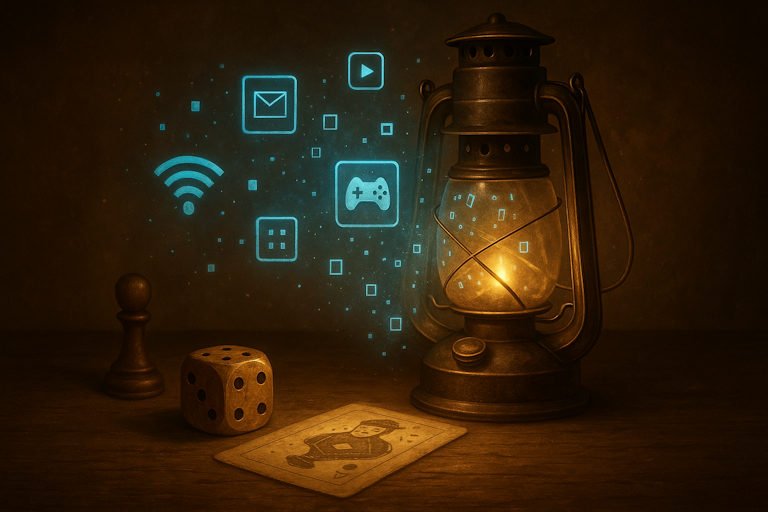
Board games vs online games: the irresistible battle for the table (2025)
Board games vs online games is a debate that keeps returning to the table. One side thrives on the tactile feel of wooden pieces and shuffled cards; the other shines through instant access, glowing screens, and endless digital variety. Both promise play, but in profoundly different ways.
What makes this clash so fascinating is that it is not just about mechanics, but about the way we connect. Around a board, we read expressions, share laughter, and bend the rules if needed. Online, we span distances, join global communities, and dive into fast-paced matches shaped by technology.
This article explores the irresistible battle between physical and digital play. We will look at tactility and social presence, pacing and interaction, convenience and cognitive impact. In the end, the question is not which side wins forever, but how each keeps reshaping the way we gather around the table.
Board games vs online games: tactility, social presence & future-proofing
Board games vs online games begins with a question of touch and presence. Physical board games invite players to handle wooden pawns, shuffle cards, and roll dice whose weight and sound anchor the experience. This tactile layer adds more than nostalgia—it creates immersion by engaging the senses. The feel of real components slows time, giving players space to connect with each move and savor the ritual of play.
That sense of presence extends beyond the objects to the people around the table. In board games, players sit face-to-face, observing expressions, tone, and body language. A raised eyebrow can be as telling as a played card; shared laughter becomes as memorable as the final score. This social immediacy is difficult to replicate online, where interactions are filtered through screens, microphones, and often unreliable connections. While digital play connects us across continents, it rarely matches the intensity of eye contact across the table.
Future-proofing adds another dimension to the battle. Board games require no servers, log-ins, or updates. A box on a shelf can remain playable for decades, surviving long after an app is unsupported or a platform disappears. Online games, though powerful in reach and convenience, are tied to the lifespan of software and hardware. Their accessibility can vanish overnight, leaving only memories where once there were vibrant communities.
Still, the strength of board games does not erase the appeal of digital play. For some, the convenience of instant setup outweighs the ritual of arranging pieces. Yet the enduring appeal of tactility and presence explains why physical games continue to thrive in an age dominated by technology. They remind us that play is not just about rules, but about how we hold, share, and preserve the experience together.
Discover
the Firefly Inn
Behind its lantern light, mysteries unfold.
Step inside and choose your path

Pacing, interaction & gameplay flow
One of the clearest differences in board games vs online games lies in pacing. Physical games often unfold at a slower rhythm, allowing players to pause, negotiate, or even bend the rules when the group agrees. This flexibility makes the experience highly social. A round of discussion, a shared joke, or an improvised house rule can shape the game as much as the printed instructions. The flow of the evening is determined by the people at the table, not just the mechanics inside the box.
Online games, by contrast, enforce pace through code. The timer starts, turns are regulated, and the flow is uniform across all players. This structure ensures fairness and speed, but it reduces the opportunity for organic interaction. In a digital match, rules are fixed, and the software rarely allows for improvisation. The focus shifts from shared presence to system-driven progression, creating tension that is sharper but also less forgiving.
Interaction is equally distinct. In board games, interaction includes not just words and moves but physical presence: the way someone hesitates before rolling, the way they shuffle their cards, or the collective cheer when a daring strategy works. These micro-moments build camaraderie and memory. Online play can replicate conversation through chat or voice, but it lacks the same texture. Body language, silence, and spontaneous gestures are filtered out, replaced by avatars and icons.
Gameplay flow follows naturally from these contrasts. Board games can stretch or contract depending on mood, while digital games deliver streamlined efficiency. Neither approach is superior in itself—one values adaptability, the other consistency. Together, they highlight the core distinction in board games vs online games: analog play bends with the players, digital play bends the players to its rules.
Discover
the Firefly Inn
Behind its lantern light, mysteries unfold.
Step inside and choose your path

Key advantages at a glance
The contrast between board games vs online games is best understood by looking at their strongest qualities side by side. Each format has its own kind of magic, shaping how we play, connect, and remember the experience.

- Tactile immersion: Handling real cards, pawns, and dice engages the senses in ways a screen cannot. The texture, weight, and sound of components slow the pace and deepen focus, making the game feel more present and grounded.
- Social dynamics: Around a table, every laugh, glance, and silence becomes part of the game. This face-to-face presence builds memories beyond the mechanics, turning an evening of play into a shared story.
- Convenience & access: Online games excel in speed and reach. With a few clicks, players can join from across the world, skip lengthy setup, and find opponents instantly. The trade-off is less flexibility in rules and atmosphere.
- Longevity & ownership: A physical board game, once bought, is always yours. No server shutdown or software update can erase it. Digital games, while powerful in reach, remain tied to platforms that may not last forever.
Taken together, these strengths explain why neither side can claim total victory. Instead, the clash of board games vs online games continues because each offers something the other cannot.
Cognitive & emotional experience
The debate of board games vs online games is not only about mechanics or convenience; it also extends to how each format shapes the mind and emotions. Research shows that both analog and digital play sharpen cognitive skills, but they do so in different ways.
Board games often emphasize patience, memory, and long-term strategy. Players must track moves across the table, recall past actions, and adapt to unexpected choices from others. This mental exercise unfolds in real time, without digital prompts to guide the way. The tactile act of moving a piece or rolling dice reinforces focus and provides natural breaks in the rhythm of thought.
Online games, by contrast, test speed, multitasking, and reactivity. Players must process visual and auditory cues instantly, juggle multiple actions at once, and stay alert to rapid changes coded into the system. This demands sharp reflexes and adaptive problem-solving, making digital play more intense and fast-paced.
Emotionally, the contrast is just as striking. Around a board, emotions are amplified by proximity: laughter, rivalry, and suspense are shared face-to-face. Online, emotions are shaped by distance—often communicated through text, voice, or avatars. While digital play builds global communities, it sometimes dilutes the intimacy that comes with direct human presence.
Ultimately, board games vs online games reflects two ways of experiencing play. One slows us down, grounding us in tactile presence and shared moments; the other accelerates, immersing us in fast, reactive environments. Both sharpen the mind and stir emotion—but in different rhythms, each leaving its own lasting imprint.
Conclusion – The irresistible battle continues
The clash of board games vs online games is not a fight with a clear winner, but a dialogue between two forms of play. Physical games invite us to slow down, to touch and feel, to share presence and laughter across the table. Digital games accelerate, connect across distance, and offer instant access to opponents worldwide. Each format satisfies a different human need—one for grounding, one for reach.
What makes the debate so compelling is that both are here to stay. The tactile weight of a pawn will never lose its charm, just as the glowing pull of an online match will never fade. They shape our cognition in different rhythms and stir our emotions in unique ways.
In the end, the battle is not about victory but balance. When the lantern light of tradition meets the glow of modern screens, we see that play itself is larger than the medium. That is why board games vs online games will always remain irresistible: two sides of the same table, forever in motion.
Discover
the Firefly Inn
Behind its lantern light, mysteries unfold.
Step inside and choose your path





